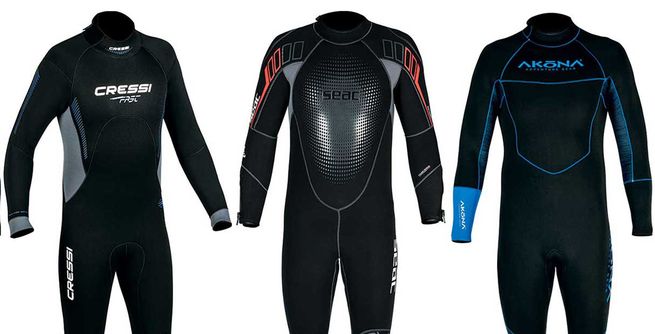Scuba Wetsuits
Knights have their armor, and divers have their neoprene—a scuba wetsuit helps keep you warm and protected underwater. Wetsuits come in varying thicknesses, trapping a layer of water between the suit and your skin. Your natural body heat warms this water up, allowing you to stay warm underwater despite the fact that your body rapidly loses heat at depth.
Comfort, fit, warmth and range of motion are key factors ScubaLab’s team of test divers considers when reviewing new wetsuits. Check out the latestScubaLab 3mm wetsuit review. But there’s no shame in placing weight on style, too. Some divers prefer a simple, no-frills look, while others want bright accents to make themselves more visible to their buddies or simply make a fashion statement.
What are wetsuits made of?
Wetsuits are made of neoprene rubber, a closed-cell foam that traps millions of tiny gas bubbles within its structure. Unlike open-cell foam (i.e., a sponge), water won’t saturate neoprene, but the gas bubbles tend to give the material a lot of inherent buoyancy. When you put on a wetsuit, your 98.6-degree body temperature warms the gas bubbles in the neoprene, which act as insulation. This, combined with a snug ft, minimizes the amount of water that enters the suit and keeps body heat from escaping.
How do you choose a scuba wetsuit?
Every diver has different needs depending on their preferences and typical diving environment. Make sure you choose the perfect scuba wetsuit by considering style, thickness and sizing.
Choosing the Right Wetsuit Type
In many tropical dive locales, the water is warm enough that you could dive in a bathing suit. But most divers still prefer to wear a full wetsuit—usually 1 to 3mm—in order to cover their skin and protect from brushing against harmful corals or stinging marine creatures. A good compromise might be a shorty, which covers your core and stretches to your elbows and knees.
A farmer john wetsuit—also called a long John or long Jane wetsuit—covers your legs and core, but has no sleeves like overalls. Some divers prefer this style so they can wear their own hooded undergarment or just a rash guard underneath.
Choosing the Right Wetsuit Fit
The two main factors you should consider when buying a scuba wetsuit are simple: fit and comfort. If your wetsuit does not fit properly it will not do its job keeping you warm at depth, and an uncomfortable suit will ruin a diver quicker than you can say Jacques Cousteau.
Make sure your wetsuit is not too tight around the neck, allowing you to breathe and turn your head comfortably without being loose enough to let excess water in. Also, touch your toes, turn your body and stretch your arms to verify that your wetsuit’s fit allows you the range of motion to dive safely.
Keep in mind that thicker scuba wetsuits—such as 5mm or 7mm options—are going to be tougher to get on. If you’re having trouble, try getting the suit wet first or wearing a thin lycra rash guard or socks underneath.
Besides your personal comfort and fit, keep the quality of the suit in mind. Take a look at the wetsuit’s seals, zippers, kneepads and zippers. Many wetsuits have special interior lining that either adds extra warmth and comfort or allows it to dry more quickly.
Choosing the Right Wetsuit Thickness
Wetsuits come in varying sizes, typically from 1mm to 7mm. Before departing on a trip or visiting your local dive spot, do research on the average water temperature from that season or call the local dive operator to get this info. Once you know how cold the water will be, check out this guide for choosing a wetsuit based on the water temperature.
How do you clean a scuba wetsuit?
Scuba wetsuits can be hand washed in a tub of warm water. It is best to use a wetsuit shampoo available from any retail dive facility to help prevent the suit from fading or breaking down the integrity of the rubber. Wetsuits can also be washed in a machine with a hand wash cycle, although it is not recommended to help maintain the neoprene. Take it out before the spin cycle and allow it to drip dry. For more on how to care for your suit, follow our guide here.
Want more info? See our complete guide to scuba gear or our guide to buying your first set of scuba gear.

